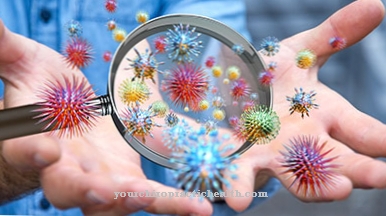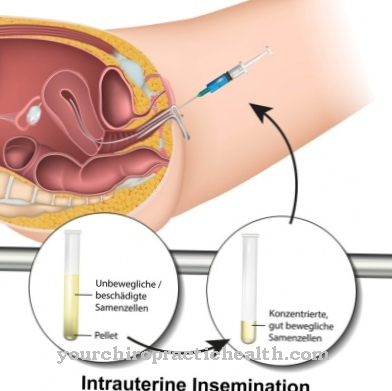A Adhesion describes the growing together of different organs. It is usually triggered by major injuries and operations. The consequences of adhesions can be both harmless and life-threatening (intestinal obstruction).
What are adhesions?
Adhesions or in medical terms Adhesions often occur after major abdominal surgery. Adhesion represents the growing together of different organs. As a result of wound healing, adhesions can occur which, if the wound has been in existence for a long time, turn into an adhesion through the formation of a layer of connective tissue. Often a strand of scar forms between the fused organs, which is also known as a bride.
Blood vessels and nerve connections continue to develop within this connective tissue cord. Colloquially, it is referred to as an "adhesion belly". The term synechia is also used as a medical term. Usually the peritoneum is involved in an adhesion. The peritoneum consists of connective tissue, which can form adhesions with other internal organs if injured. Adhesion can also occur in endometriosis. If the adhesive film persists for more than five days, new connective tissue cells form, which connect the connective tissue of the various organs with one another.
root cause
In most cases, the cause of adhesions is surgical intervention in the abdominal cavity, which injures the peritoneum. But peritonitis can also lead to adhesions. In addition, endometriosis sometimes plays a role in the development of adhesions in women. Endometriosis is a benign, but painful, chronic disease that is characterized by the presence of uterine tissue outside the uterine cavity on foreign organs.
If, for example, the peritoneum is injured, a layer of fibrin is formed to cover the wound. Fibrin is a sticky coating that is said to speed up the healing process. However, the organs within the abdominal cavity are very close to one another and are often only separated from one another by a film of liquid over a narrow gap. However, sticking can then occur at damaged areas. The fibrin coating is normally broken down again within five days after the wound has started to heal. The neighboring organs separate again.
However, if the breakdown of fibrin is delayed, new connective tissue cells are created which connect the peritoneum with the connective tissue of the other organ. An intergrowth develops. Adhesions can develop anywhere in the abdomen after an operation. If the wound fluid is carried over, it is even possible that an adhesion occurs at a point in the abdominal cavity that is far away from the operation.
Symptoms, ailments & signs
Adhesions are usually harmless and do not cause any symptoms. In a few cases, however, they can also have serious consequences.However, chronic pelvic pain often occurs, which is caused by the reduced mobility of the organs affected by the adhesions.
Nerve connections are formed within the adhesions that cause pain when stressed. The pain often affects the patient's quality of life. However, worse consequences result from the possible late effects.
In the case of adhesions in the area of the ovary or fallopian tube, for example, infertility can occur because the egg transport is no longer optimal. However, a far worse consequence could result from an adhesion with the intestine. In addition to chronic abdominal pain, irregular stool and flatulence, the development of an intestinal obstruction is also possible.
Diagnosis & course of disease
The diagnosis of adhesions is often difficult because the symptoms are usually unspecific. In X-ray or ultrasound examinations, adhesions are often not found at all. If an adhesion is suspected, however, imaging methods such as high-resolution ultrasound or a special abdominal nuclear spin tomography can provide information about it. But these techniques are not specific enough either. Only a laparoscopy using the keyhole technique can clearly demonstrate an adhesion.
Complications
In most cases, the adhesions do not cause discomfort or complications. They occur very frequently and are a common symptom after an operation. However, adhesions can lead to severe pain in the patient's abdomen.
This pain also results in significantly reduced mobility and has a very negative effect on the patient's quality of life. Furthermore, those affected may suffer from paralysis or other disorders of sensitivity, since the adhesions can pinch nerves or even damage them completely. In women, adhesions can also lead to infertility if they have a negative effect on egg transport.
Those affected also suffer from symptoms in the intestinal area, which in the worst case can lead to an intestinal obstruction. Gas and flatulence also occur, which continue to make everyday life much more difficult for the person affected. As a rule, adhesions can be treated with surgical interventions.
However, they can also be avoided directly during the procedure. There are no complications. If the adhesions are diagnosed at an early stage, the course of the disease will be positive. The life expectancy of the patient is also not negatively affected.
When should you go to the doctor?
Regular personal hygiene should be carried out to avoid adhesions. The control of the growth of nails can usually be carried out independently or by nurses. A doctor is not necessary for the processes of physical cleansing. In addition, regular foot care or manicure applications can be used to eliminate symptoms at an early stage. Medical help is required if there are impairments that can no longer be remedied with your own means. Pain, restricted mobility or changes in the skin's appearance should be examined and treated. If there are circulatory disorders, abnormal gait or uncertainties in locomotion, action is required.
The formation of pus should be monitored as it can lead to sepsis in severe cases. If there are peculiarities of pus development, a doctor is needed. Disruptions in coping with everyday obligations, a visual flaw or poor posture should also be discussed with a doctor. Any general persistent malaise, a feeling of illness or a steady increase in symptoms should be clarified by a doctor. Medical tests are needed to diagnose and clarify the cause. To avoid long-term damage or permanent impairment of quality of life, a doctor should be consulted if the physical irregularities persist for several weeks.
Therapy & Treatment
Treating an adhesion is often difficult. The fused organs can be separated again by a new operation. Often, however, new adhesions develop again. The chronic pain only temporarily disappears immediately after the operation and returns after a while. If there are only individual brides, the operation promises to be a success. However, that is not guaranteed either.
If there are several adhesions, it will be waited to see whether the symptoms subside without an operation. The operation is usually performed using a keyhole procedure. Today there are methods of using so-called adhesion barriers during surgery. These are solid or liquid separating layers that are intended to prevent the different fabrics from sticking together. Solid adhesion barriers are membranes that are applied to the wound site after the operation to hold the tissues apart during the healing process.
After healing, these barriers break down again after a few weeks. When using liquid adhesion barriers, the entire abdominal cavity is rinsed after the operation in order to avoid sticking. After a few days, the body has completely absorbed the fluid. Even with these methods, however, there is no complete guarantee of avoiding adhesion.
prevention
To prevent adhesions, more and more gentle surgical technologies are used that cause as few tissue defects as possible. That is why keyhole operations are being used more and more frequently. After extensive surgical interventions, solid or liquid adhesion barriers can now be used prophylactically. However, the success of these methods has not yet been clearly proven by medical studies and is therefore not yet being used across the board.
Aftercare
Follow-up care for adhesions - mostly caused by accidents or operations - does not rule out the need for another surgical treatment. This depends on the complaints and restrictions for the patient that result from the adhesions. If there are no symptoms, no special follow-up care is required and in many cases the adhesions are only detected by a chance diagnosis in the course of other treatments or examinations.
However, if an overgrowth causes discomfort to organs, the overgrown areas must be surgically restored to their normal state. In the case of adhesions in the abdomen, this can often be done by endoscopic surgery under general anesthesia. The hospital stay is short, but depends on the extent and degree of adhesions. There are no own methods or home remedies for alleviating adhesions, here only an expert doctor can help the patient and take care of the aftercare.
Adhesions of the skin, for example due to burns, are a special feature. These can usually be quickly remedied by small outpatient operations or sometimes even purely non-invasive therapy at the dermatologist. No special follow-up care is then required here, as the cause is no longer present.
You can do that yourself
Adhesions usually have to be removed surgically and the pain treated with medication. Those affected can do a few things themselves to reduce the adhesions or to support medical treatment. First of all, massages and the use of natural pain relievers are recommended. Regular pressure massage can loosen the tissue. In addition to massages, acupuncture or acupressure may also be an option. Acupressure can be particularly useful for nerve pain. Depending on the location of the adhesions, yoga or physiotherapy can also be used as supportive measures.
If the adhesions have a negative effect on mental health because self-esteem suffers, talk therapy is recommended. Conversations with friends or family members who themselves suffer from adhesions are often more effective.
In the long term, adhesions that cannot be removed by massage must be treated surgically. After a surgical procedure, typical general measures apply, such as monitoring the surgical wound and protecting the body. Sports activity is mostly forbidden, as rapid and intense movements can open the seams. If this happens, the doctor must be informed immediately. In general, adhesions can be treated well, provided the patient takes the right measures.





.jpg)
.jpg)




















